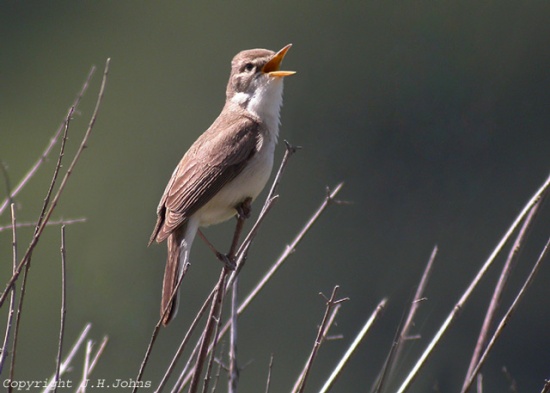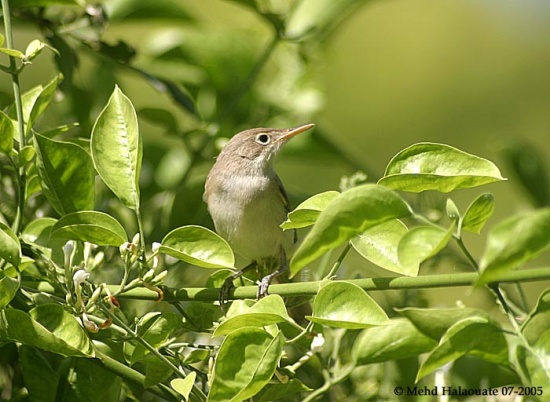| Line 4: | Line 4: | ||
[[Image:Olivaceous_Warbler.jpg|thumb|550px|right|Photo by john-henry<br />(Eastern) Olivaceous Warbler photographed in Lesbos, Greece.]] | [[Image:Olivaceous_Warbler.jpg|thumb|550px|right|Photo by john-henry<br />(Eastern) Olivaceous Warbler photographed in Lesbos, Greece.]] | ||
==Identification== | ==Identification== | ||
| − | + | 12-15 cm. Tail relatively long and square-endeed (sides rounded). Dull grey-brown above, white below, dull grey-brown tinge to flanks and chest. Buffy white eye-ring, lores and poorly marked supercilium. Upper mandible black, lower dull orange-yellow. Western race (''see Taxonomy'') is slightly larger, heavier-billed and browner than the eastern races. | |
==Distribution== | ==Distribution== | ||
| − | The western subspecies (''see Taxonomy'') breeds in Spain and NW Africa | + | The western subspecies (''see Taxonomy'') breeds in [[Spain]] and NW [[Africa]]. |
| − | The eastern subspecies breeds | + | The eastern subspecies breeds through [[Greece]], [[Crete]], [[Cyprus]], [[Turkey]], [[Middle East]], the [[Caucasus]], [[Iran]] and [[Afghanistan]]. |
| − | + | [[Image:Western_Olivaceous_Warbler.jpg|thumb|550px|left|Photo by mehdhalaouate<br />(Western) Olivaceous Warbler photographed in Marrakech, SW Morocco.]] | |
| − | |||
==Taxonomy== | ==Taxonomy== | ||
Now commonly split into two species based on mtDNA, song, morphology and behavior: | Now commonly split into two species based on mtDNA, song, morphology and behavior: | ||
| Line 19: | Line 18: | ||
* Western Olivaceous/Isabelline Warbler (''H. opaca''). | * Western Olivaceous/Isabelline Warbler (''H. opaca''). | ||
* Eastern Olivaceous Warbler (''H. pallida'', with races ''reiseri'', ''elaeica'', ''laeneni'' and ''alulensis''). | * Eastern Olivaceous Warbler (''H. pallida'', with races ''reiseri'', ''elaeica'', ''laeneni'' and ''alulensis''). | ||
| + | |||
==Habitat== | ==Habitat== | ||
| − | Wide range of wooded and brushy habitats | + | Wide range of wooded and brushy habitats. |
==Behaviour== | ==Behaviour== | ||
| − | + | Diet includes insects and spiders and some fruits. | |
| + | |||
| + | The nest is a cup made of plant-material placed fairly low in the fork of a branch. 3-5 eggs are laid and incubated by the female, but both parents feed the nestlings. | ||
==Bird Song== | ==Bird Song== | ||
Revision as of 14:28, 9 November 2007
- Hippolais pallida
Includes Western Olivaceous/Isabelline Warbler (H. opaca). See section on Taxonomy.
Identification
12-15 cm. Tail relatively long and square-endeed (sides rounded). Dull grey-brown above, white below, dull grey-brown tinge to flanks and chest. Buffy white eye-ring, lores and poorly marked supercilium. Upper mandible black, lower dull orange-yellow. Western race (see Taxonomy) is slightly larger, heavier-billed and browner than the eastern races.
Distribution
The western subspecies (see Taxonomy) breeds in Spain and NW Africa.
The eastern subspecies breeds through Greece, Crete, Cyprus, Turkey, Middle East, the Caucasus, Iran and Afghanistan.
Taxonomy
Now commonly split into two species based on mtDNA, song, morphology and behavior:
- Western Olivaceous/Isabelline Warbler (H. opaca).
- Eastern Olivaceous Warbler (H. pallida, with races reiseri, elaeica, laeneni and alulensis).
Habitat
Wide range of wooded and brushy habitats.
Behaviour
Diet includes insects and spiders and some fruits.
The nest is a cup made of plant-material placed fairly low in the fork of a branch. 3-5 eggs are laid and incubated by the female, but both parents feed the nestlings.
Bird Song
<flashmp3>Hippolais pallida (song).mp3</flashmp3>
Listen in an external program





